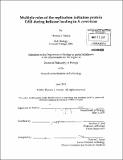Multiple roles of the replication initiation protein Cdtl during helicase loading in S. cerevisiae
Author(s)
Takara, Thomas J. (Thomas Joji)
DownloadFull printable version (9.743Mb)
Other Contributors
Massachusetts Institute of Technology. Dept. of Biology.
Advisor
Stephen P. Bell.
Terms of use
Metadata
Show full item recordAbstract
The faithful transmission of genetic information is critical for the events of cell division and propagation. In eukaryotic cells, chromosomal replication is carefully coordinated with the cell cycle to ensure that the entire genome is replicated exactly once prior to cell division. Underpinning this coordination is the tightly regulated loading and activation of the eukaryotic replicative DNA helicase, the hetero-hexameric Mcm2-7 complex. As cells enter G1 phase of the cell cycle, all potential sites of replication initiation are selected by the loading of inactive Mcm2-7 double hexamers. The anti-parallel orientation of the Mcm2-7 hexamers within the double hexamer is proposed to be critical to establish bidirectional sister replisomes upon helicase activation in S phase. Although the proteins involved in helicase loading are known, the mechanism that drives Mcm2-7 double-hexamer formation and loading is unclear. The replication initiation protein Cdtl is essential for loading Mcm2-7 onto origin DNA, but its functions during the loading event are unclear. Through analysis of Cdtl mutations, I identified regions of Cdtl that are essential for Mcm2-7 helicase binding, origin recruitment, and activation. I found that multiple Cdtl molecules are recruited to the origin during the helicase-loading process, and disrupting of the assembly of the multi-Cdtl intermediate prevents Mcm2-7 loading. Finally, I demonstrated that the Nterminal domain of Cdtl, although dispensable for stable helicase loading, is required for subsequent helicase activation and replication initiation. These findings reveal that Cdtl performs multiple functions during helicase loading and influences the competence of loaded Mcm2-7 to subsequently become activated. This work provides insight into the process of Mcm2-7 double-hexamer loading and supports a model in which Cdtl initiates Mcm2-7 double-hexamer formation early in the helicase-loading process.
Description
Thesis (Ph. D.)--Massachusetts Institute of Technology, Dept. of Biology, 2011. Cataloged from PDF version of thesis. Includes bibliographical references.
Date issued
2011Department
Massachusetts Institute of Technology. Department of BiologyPublisher
Massachusetts Institute of Technology
Keywords
Biology.